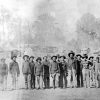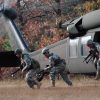calsfoundation@cals.org
Scout from Batesville to West Point, Grand Glaize, Searcy Landing, etc.
The wide-ranging scouting expedition of the Eleventh Missouri Cavalry Regiment (US) that left the Union base at Batesville (Independence County) on March 15, 1864, was one of an almost continuous series of sorties seeking information on the location of Confederate troops and guerrillas in the region.
Major Lewis C. Pace led 200 Eleventh Missouri troopers out of Batesville on March 15, sending half of them under Captain James A. Collier to head toward the Little Red River by way of Fair View (White County) and West Point (White County), while Pace took the remainder down the White River to Oil Trough Bottom (Independence County), where they made camp.
On March 17, Pace’s column headed to Grand Glaise (Jackson County), then southwest toward West Point. They stopped at William Plant’s home seven miles from Grand Glaise and found that Plant’s home was “a depot for Southern mails” but, on examining the rebel letters, determined they were “more of a matrimonial character than otherwise” and returned them to him for delivery. Two Confederate soldiers were captured at Grand Glaise.
The two Union forces met up on March 18 and headed toward Searcy Landing (White County), where they found one flatboat being used as a ferry and another under construction, which Pace reported could easily be converted to a pontoon bridge if needed later.
Turning north until about five miles from Cedar Grove (Independence County), the Federals turned west up the Little Red and headed toward Sugar Loaf Spring (now Heber Springs in Cleburne County), where a Captain Little, who was a guerrilla chieftain, and some of his men were said to be camped. Pace reported that a deserter from his party was heading to warn Little, so he put 100 of his men on the best horses available in pursuit but “found on reaching his camp that he had been gone forty or fifty minutes.” The Missourians chased them for three miles, but Little’s men scattered into the countryside, so the Federals turned back and spent the night in the guerrilla camp.
They set out on the morning of March 19 toward Kinderhook (now Edgemont in Cleburne County) and found evidence that Captain George Rutherford’s Confederates had passed through. Pace sent scouts out seeking the guerrillas, but said that “the information was such as led me to believe that he had moved from Little Red River over onto White River in the neighborhood of Buck Horn.” Pace put his men on a grueling forty-mile forced march to head Rutherford off at Richwoods (Stone County), but at a Colonel Kemp’s place, he said, “I ascertained that he had not gone up the river.”
Heading back to Batesville, the column captured a Captain Hancock and three Confederate soldiers on Racoon Creek in Izard County, turning all six of his prisoners over to the provost guard at the Union base. Pace reported that “the country of which I traveled is a rough, rocky, and mountainous country, destitute of forage excepting in the valleys and coves of the mountains, and very little can be found in them.” His seven-day scout had covered 206 miles.
For additional information:
The War of the Rebellion: A Compilation of the Official Records of the Union and Confederate Armies, Series I, Vol. 34, part 1, pp. 640–641. Washington DC: Government Printing Office, 1891.
Mark K. Christ
Central Arkansas Library System
 Civil War Timeline
Civil War Timeline Military
Military



Comments
No comments on this entry yet.